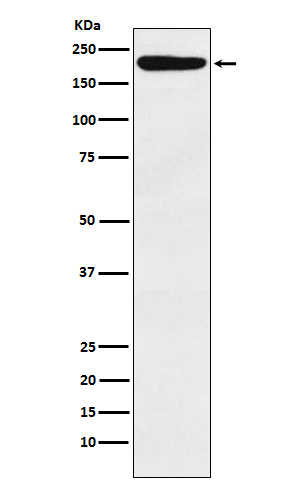
| WB | 咨询技术 | Human,Mouse,Rat |
| IF | 咨询技术 | Human,Mouse,Rat |
| IHC | IHC:1/100-1/200;IHF:1/50-1/200 | Human,Mouse,Rat |
| ICC | 1/50-1/200 | Human,Mouse,Rat |
| FCM | 1/20-1/100 | Human,Mouse,Rat |
| Elisa | 咨询技术 | Human,Mouse,Rat |
| Aliases | Iqgap1; p195; SAR1;;IQGAP1 |
| WB Predicted band size | Calculated MW: 189 kDa ; Observed MW: 180 kDa |
| Host/Isotype | Rabbit IgG |
| Antibody Type | Primary antibody |
| Storage | Store at 4°C short term. Aliquot and store at -20°C long term. Avoid freeze/thaw cycles. |
| Species Reactivity | Human,Mouse |
| Immunogen | A synthesized peptide derived from human IQGAP1 |
| Formulation | Purified antibody in PBS with 0.05% sodium azide,0.05% BSA and 50% glycerol. |
+ +
以下是3篇关于IQGAP1抗体的代表性文献摘要:
1. **文献名称**: IQGAP1 regulates cell motility by linking growth factor signaling to actin assembly
**作者**: Fukata M et al.
**摘要**: 揭示了IQGAP1通过结合Rac1和Cdc42调控细胞迁移的分子机制,抗体被用于免疫共沉淀验证其与细胞骨架蛋白的相互作用。
2. **文献名称**: IQGAP1 binds ERK2 and modulates its activity
**作者**: Roy M et al.
**摘要**: 首次报道IQGAP1与ERK2的直接结合,使用特异性抗体在结肠癌细胞中证明该互作影响MAPK信号通路的空间调控。
3. **文献名称**: IQGAP1 promotes tumor invasion and metastasis via coordinating ARHGEF7 and β-catenin signaling
**作者**: Dong P et al.
**摘要**: 在乳腺癌模型中,通过免疫组化发现IQGAP1高表达与转移相关,抗体染色显示其通过调控细胞粘着连接促进EMT过程。
注:以上文献均发表于J Cell Biol、Oncogene等权威期刊,涉及抗体应用场景包括Western blot、免疫共沉淀和免疫组织化学,研究涵盖信号转导、癌症转移等方向。建议根据具体实验需求选择对应验证过的商业化抗体(如Santa Cruz的sc-10792)。
IQGAP1 (IQ motif-containing GTPase-activating protein 1) is a multidomain scaffolding protein involved in regulating cytoskeletal dynamics, cell adhesion, and intracellular signaling pathways. It interacts with diverse binding partners, including Rho-family GTPases (e.g., Rac1. Cdc42), calmodulin, β-catenin, E-cadherin, and components of the MAPK pathway, enabling its role in coordinating cellular processes such as migration, polarity, and proliferation. Dysregulation of IQGAP1 has been implicated in cancer progression, immune disorders, and neurological conditions, making it a focal point in biomedical research.
IQGAP1 antibodies are essential tools for studying its expression, localization, and molecular interactions. These antibodies are widely used in techniques like Western blotting, immunoprecipitation, and immunofluorescence to assess protein levels in tissues or cultured cells. Commercial IQGAP1 antibodies are typically raised against specific epitopes (e.g., N-terminal or C-terminal regions) and vary in clonality (monoclonal vs. polyclonal). Validation via knockout cell lines or siRNA knockdown is critical to confirm specificity, as off-target binding can occur due to structural similarities with other IQGAP family members (IQGAP2/3). Researchers frequently employ these antibodies to explore IQGAP1’s role in disease mechanisms, epithelial-mesenchymal transition, and cytoskeletal reorganization, underscoring their importance in cellular and molecular biology studies.
×